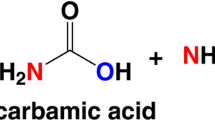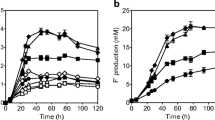Abstract
For lindane degradation, a cell suspension of Clostridium rectum strain S-17 demands the addition of substrates such as leucine, alanine, pyruvate, a leucine-proline mixture, and molecular hydrogen. In the presence of leucine-proline mixture, lindane decomposed in parallel with isovaleric acid formation, and both lindane degradation and isovaleric acid formation were inhibited by monoiodoacetic acid, suggesting a close relation between lindane degradation and the Stickland reaction. Lindane was degraded by cell-free extracts of C. rectum in the presence of dithiothreitol (DTT). Radiogaschromatograms of n-hexane soluble metabolites from [14C] lindane showed the presence of monochlorobenzene and γ-3,4,5,6-tetrachlorocyclohexene, Leucine, NADH, and NADPH were somewhat less active than DTT for lindane degradation in cell-free extracts. Reductive dechlorination seemed the major route of lindane degradation in cell-free extracts as well as in the intact cells of C. rectum.
Similar content being viewed by others
Abbreviations
- Lindane (γ-HCH):
-
γ-1,2,3,4,5,6-hexachlorocyclohexane
- α-HCH:
-
α-1,2,3,4,5,6-hexachlorocyclohexane
- γ-TCH:
-
γ-3,4,5,6-tetrachlorocyclohexene
- γ-PCH:
-
γ-1,3,4,5,6-pentachlorocyclohexene
- DTT:
-
1,4-dithiothreitol
References
Beland, F. A., Farwell, S. O., Robocker, A. E., Geer, R. D.: Electrochemical reduction and anaerobic degradation of lindane. J. Agric. Food Chem. 24, 753–756 (1976)
Bradbury, F. R., Nield, P.: Amount of γ-benzene hexachloride picked up by resistant houseflies bred on a medium containing benzene hexachloride. Nature 172, 1052–1053 (1953)
Chadwick, R. W., Chuang, L. T., Williams, K.: Dehydrogenation: a previously unreported pathway of lindane metabolism in mammals. Pestic. Biochem. Physiol. 5, 575–586 (1975)
Fukami, H., Kimura, H., Nakazima, M.: On electrolysis of γ-BHC with the cathode controlled potential and determination of small amounts of benzene in aqueous alcohol solution. Botyu-Kagaku 18, 51–57 (1953)
Heritage, A. D., MacRae, I. C.: Identification of intermediates formed during the degradation of hexachlorocyclohexanes by Clostridium sphenoides. Appl. Environ. Microbiol. 33, 1295–1297 (1977)
Jagnow, G., Haider, K., Ellwardt, P.: Anaerobic dechlorination and degradation of hexachlorocyclohexane isomers by anaerobic and facultative anaerobic bacteria. Arch. Microbiol. 115, 285–292 (1977)
Kurihara, N., Nakajima, M.: Studies on BHC isomers and related compounds. VIII. Urinary metabolites produced from γ- and β-BHC in the mouse: chlorophenol conjugates. Pestic. Biochem. Physiol. 4, 220–231 (1974)
Kurihara, N., Tanaka, K., Nakajima, M.: Anaerobic metabolism of lindane and related compounds by liver microsomes. In: Advances in pesticide science, Part 3 (H. Geissbühler, ed.), pp. 557–561. Oxford: Pergamon Press 1979
Lowry, O. H., Rosebrough, N. J., Farr, A. L., Randall, R. J.: Protein measurement with the Folin phenol reagent. J. Biol. Chem. 193, 265–275 (1951)
MacRae, I. C., Raghu, K., Bautista, E. M.: Anaerobic degradation of the insecticide lindane by Clostridium sp. Nature 234, 551–552 (1969)
Matsumura, F., Benezet, H. J., Patil, K. C.: Factors affecting microbial metabolism of γ-BHC. J. Pestic. Sci. 1, 3–8 (1976)
Nisman, B.: The Stickland reaction. Bacteriol. Rev. 18, 16–42 (1954)
Ohisa, N., Yamaguchi, M.: Gamma-BHC degradation accompanied by the growth of Clostridium rectum isolated from paddy field soil. Agric. Biol. Chem. 42, 1819–1823 (1978a)
Ohisa, N., Yamaguchi, M.: Degradation of gamma-BHC in flooded soil enriched with peptone. Agric. Biol. Chem. 42, 1983–1987 (1978b)
Ohisa, N., Yamaguchi, M.: Clostridium species and γ-BHC degradation in paddy soil. Soil Biol. Biochem. 11, 645–649 (1979)
Stadtman, T. C.: Studies on the enzymic reduction of amino acids. V. Coupling of a DPNH-generating system to glycine reduction. Arch. Biochem. Biophys. 99, 36–44 (1962)
Tanaka, K., Kurihara, N., Nakajima, M.: Oxidative metabolism of lindane and its isomers with microsomes from rat liver and house fly abdomen. Pestic. Biochem. Physiol. 10, 96–103 (1979)
Takeda, K., Furusaka, C.: Studies on the bacteria isolated anaerobically from paddy soil. III. Production of fatty acids and ammonia by Clostridium species. Soil Sci. Plant Nutr. 21, 113–118 (1975)
Author information
Authors and Affiliations
Rights and permissions
About this article
Cite this article
Ohisa, N., Yamaguchi, M. & Kurihara, N. Lindane degradation by cell-free extracts of Clostridium rectum . Arch. Microbiol. 125, 221–225 (1980). https://doi.org/10.1007/BF00446880
Received:
Issue Date:
DOI: https://doi.org/10.1007/BF00446880




